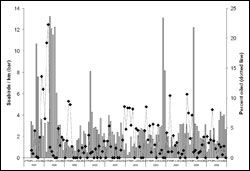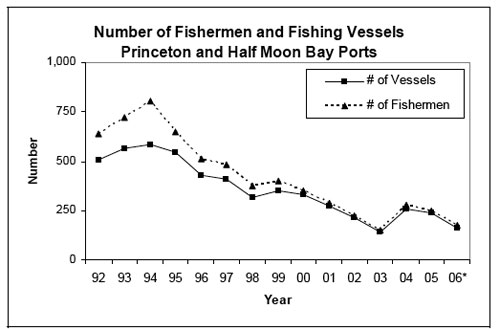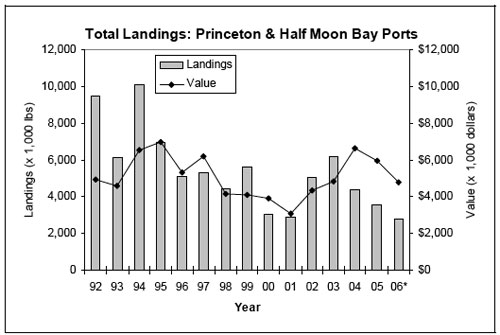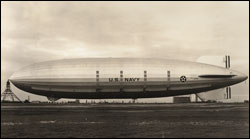 | ||||||||||||||||||||||||||||||||||||||||||||||||||||||||||||||||||||||||||||||||||||||||||||||||||||||||||||||||||||||||||||||||||||||||||||||||||||||||||||||||||||||||||||||||||||||||||||||||||||||||||||||||||
|
|
|
|
|
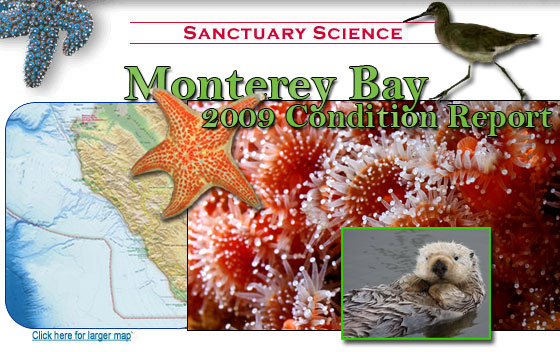
The following information provides an assessment of the status and trends pertaining to water quality in the offshore environment. 1. Are specific or multiple stressors, including changing oceanographic and atmospheric conditions, affecting water quality and how are they changing? Stressors on water quality in the offshore environment, specifically persistent organic pollutants (POPs), fluctuations in nutrient levels, and changing ocean conditions, may inhibit the development of assemblages and may cause measurable declines in living resources and habitats. For this reason the rating for this question is "fair" with a "declining" trend. Offshore waters have shown elevated levels of contaminants (CCLEAN 2007), ocean temperature and chemistry changes (MBARI 2006), some of which have been linked to changes in the offshore ecosystem (Tanner 2006).
While the overall ecological effects of stressors are difficult to measure because they are the result of complex interactions among biological and environmental factors, there is recent evidence of the deleterious effects of POPs in the marine environment. CCLEAN (2007) has found that suspended sediment from rivers, primarily the Pajaro River, may have negative effects on benthic organisms along the 80-meter contour. Moreover, the cumulative concentrations of POPs were associated with decreased abundance of some benthic infauna. Preliminary work from Miller et al. (2007) showed that southern sea otters with moderate or high exposure to freshwater flows had significantly higher concentrations of certain POPs (DDDs, DDE, HCH delta, dibenzothiophene C2 and PBDE 017) compared to those that came from areas with low exposure to freshwater flows. This study also suggests that some POPs may contribute to the risk of sea otter death due to infectious agents and trauma.
2. What is the eutrophic condition of sanctuary waters and how is it changing? The offshore environment is rated "good/fair" relative to this question because monitoring data suggests that selected conditions may preclude full development of living resource assemblages and habitats, but are not likely to cause substantial or persistent declines. A "declining" trend is supported by evidence of nutrient enrichment, increasing nutrient loading, and increasing frequency and intensity of harmful algal blooms in selected areas of the offshore environment. In this context, eutrophication refers to the human accelerated process of organic enrichment of water bodies that can lead to hypoxia and anoxia, habitat degradation, alteration of food-web structure, loss of biodiversity, and alteration of harmful algal bloom (HAB) dynamics (Howarth 2008). Humans could be influencing algal blooms by increasing nutrient availability via runoff, causing climate change, or by assisting in the transport of new species into an area (Gilbert et al. 2005, CIMT 2006). Human-derived runoff, sewage, and fertilizers may be interacting with increased sea surface temperatures to alter the natural pattern of algal blooms. HAB dynamics in California appear to be dominated by large-scale oceanographic forcing of nutrient dynamics (Anderson et al. 2008, Kudela et al., 2005, Kudela et al., 2004), however, there is growing evidence to suggest that the spatial extent, duration, and toxicity of events can be influenced by anthropogenic nutrient inputs. While evidence for direct causative links between HABs and coastal runoff and/ or eutrophication are lacking, there is abundant correlative evidence within Monterey Bay and in other areas of California (Anderson et al. 2008). Strong linkages have been demonstrated between nutrient enrichment and phytoplankton production in estuarine and marine waters for a wide range of geographic scales (Nixon 1992, Mallin et al. 1993). Scholin et al. (2000) provided indirect evidence that a massive HAB event in Monterey Bay was triggered by post-El Niño runoff. Domoic acid production by Psuedo-nitzchia species has been shown to be responsive to inputs from coastal watersheds including copper (Ladizinsky 2003) and urea (Howard et al. 2006). Toxic HAB species (Pseudo-nitzchia and Alexandrium catenella) may use dissolved organic nitrogen forms such as urea, which has been measured at substantial concentrations in nearshore waters and is likely derived from anthropogenic sources (Cochlan et al. 2008, Anderson et al. 2008).
HABs can negatively affect the ecosystem either due to their production of toxins or due to the manner in which the cells' physical structure or accumulated biomass affect co-occurring organisms and alter food web dynamics (Anderson et al. 2002). In California, HAB problems are dominated by two organisms, Alexandrium catenella, which produces a toxin that causes paralytic shellfish poisoning (PSP) and Pseudo-nitzchia, which produces the neurotoxin domoic acid (Anderson et al. 2008). Domoic acid and PSP toxins have been detected in the offshore food web in Monterey Bay and in some cases have been linked to mortality events of seabirds and marine mammals (Fritz et al. 1992, Scholin et al. 2000, Jester 2008). HABs (including those from algal species that do not produce toxins) can deplete oxygen levels as the blooms decay or they can destroy habitat for fish or shellfish by blocking light from reaching submerged vegetation. In 2007, a bloom of the dinoflagellete Akashiwo sanguinea was responsible for a mass-stranding event of seabirds in Monterey Bay. Jessup et al. (2009) determined that the algae did not produce a biotoxin, but instead produced a detergent-like protein that dissolved the natural oils found in the feathers of seabirds, which prevented the birds from flying, hunting, and keeping warm. In all, 550 birds were found stranded, while 207 were found dead. 3. Do Sanctuary waters pose risks to human health? A rating of "good/fair" is given in response to the question with an "undetermined" trend since selected conditions have the potential to affect human impacts, but impacts have not been reported. Selected conditions in offshore waters, including low levels of a number of toxic pollutants and toxins produced by HABs have the potential to affect human health. While there is some evidence of increasing loads of biotoxins and contaminants, a clear trend in the risk to human health could not be determined. POPs and biotoxins tend to biomagnify as they are passed up the food chain, and long-term exposure can be toxic to a wide range of animals, including humans. Some large, wide-ranging species of fish, marine mammals (e.g., killer whales), and pelagic seabirds (e.g., Black-Footed Albatross) found in offshore waters of the sanctuary have been tested for contaminants and show detectable levels of some contaminants such as DDT, PCBs, and chlordanes (Black et al. 2003, Kannan et al. 2004, Finkelstein et al. 2007). Such contamination, however, has not been directly linked to the water quality conditions in the offshore environment of the sanctuary. Similarly, elevated concentrations of some trace metals, such as mercury, are a health concern for humans who consume some species of large pelagic fishes, such as swordfish and albacore tuna. However, trace metal concentrations are not being monitored in either the offshore waters or in offshore species. Thus, it is not known if fishes harvested in the sanctuary have elevated levels of these contaminants or if the offshore environment of the sanctuary is a significant source of trace metals into the offshore ecosystem. The toxins produced during harmful algal blooms can accumulate in the marine food web, especially in some fishes and shellfish, and therefore, pose a health risk when consumed. For example, in 1991 and 1998 large blooms of Pseudo-nitzschia australis, a diatom that can produce the neurotoxin domoic acid, were observed in Monterey Bay. Subsequently, domoic acid was detected in planktivorous fishes (e.g., anchovy, sardines) and linked to the deaths of fish-eating birds and mammals (Fritz et al. 1992, Scholin et al. 2000). Recent studies have shown that inputs of urea and copper may promote the growth of domoic acid-producing phytoplankton and may increase the production of domoic acid resulting in higher toxicity blooms (Armstrong et al. 2007). A shift in the taxonomic structure of the phytoplankton community occurred in 2004 towards dinoflagellate species that produce paralytic shellfish poisoning toxins rather than domoic acid (Jester 2008). PSP toxins were detected in samples of northern anchovies and Pacific sardines collected between 2003 and 2005, which was the first time these toxins have been detected in California's pelagic food web (Jester 2008). 4. What are the levels of human activities that may influence water quality and how are they changing?
The level of human activities that directly influence offshore water quality are considered to be "fair" in that they result in measurable local impacts to the ocean and "improving" due to increased regulation and remediation efforts since establishment of the sanctuary. In many instances it is difficult or impossible to directly measure the impacts of human activity on offshore water quality conditions, but select activities have notable impacts. The main contributor from land-based activities is inputs of contaminants and nutrients linked to urban development and agriculture. The main activity occurring in the offshore waters of the sanctuary is vessel traffic, which can result in acoustic impacts and discharge of ballast water, bilge oil, and trash. In recent years, algal blooms in Monterey Bay have occurred more frequently and have been more persistent than in past years (CIMT 2006). Humans could be influencing algal blooms by increasing nutrient availability via runoff, climate change, or by assisting in the transport of new species into an area (Glibert et al. 1995, CIMT 2006). Human-derived runoff, sewage, and fertilizers may be interacting with increased sea surface temperatures to alter the natural pattern of blooms.
Sanctuary regulations prohibiting the dumping of grey water and bilge water, including recent additional limitations on discharges from cruise ships, serve to reduce some impacts of these activities on water quality. For example, the Beach COMBERS monitoring program found that the average oiling rate of beachcast bird carcasses (percent oiled carcasses per kilometer per month) was 2% during 1997-2002, which was less than the 8% oiling rate recorded by Pt. Reyes Bird Observatory during 1971 - 1985 (Nevins et al. 2003). This comparison indicates that oil pollution prevention measures implemented during the past 20 years have likely reduced oiling rates in the sanctuary. However, the continued observation of oiled bird carcasses on sanctuary beaches (Nevins et al. in prep) and the observation of oil slicks during aerial surveys of offshore living resources from 2001 to 2008 (K. Forney, NMFS-SWFSC, unpubl. monitoring data) suggest that continued mitigation and enforcement of sanctuary regulations is needed to further reduce the release of oil discharge into the offshore waters of the sanctuary. 
The offshore environment of the sanctuary can be divided into pelagic habitats (i.e., the water column) and benthic habitats (i.e., the seafloor). Pelagic habitats are more difficult to define than benthic habitats, and although these habitats play a key role in the sanctuary ecosystem, they are less well studied than the benthic habitats. This is due, in part, to the logistical and economic hurdles that must be overcome when using large vessels to deploy nets, remotely operated vehicles or submersibles to sample and explore this vast volume of water that is in a constant state of flux. Nevertheless, it is widely recognized that the productivity of the offshore ecosystem supports a great diversity and abundance of invertebrates, fishes, seabirds, and marine mammals. It should be noted, however, that due to the relative dearth of biological knowledge on the water column itself, the offshore environment status and trends are focused primarily on benthic habitats, since this is where the bulk of knowledge resides. The physical and chemical oceanography of the offshore pelagic habitat was discussed in the Water Quality section (above). The following information provides an assessment of the status and trends pertaining to the current state of offshore marine habitats. 5. What is the abundance and distribution of major habitat types and how is it changing? The abundance and distribution of major habitat types in the offshore environment of the sanctuary is rated as "fair" based on the past and current levels of human activities that influence the distribution, abundance, and quality of benthic habitats and associated living resources. The trend could not be determined due to a lack of information on both the rate and degree of recovery of habitat and associated living resources inside areas recently closed to bottom-contact fishing gear and the associated changes in the distribution and intensity of fishing activities in the remaining open areas. The most abundant habitats in the Monterey Bay sanctuary are the open waters - three-dimensional habitats not associated with the seafloor. The total volume of open waters of the sanctuary is 12.026 trillion cubic meters or approximately 4.8 billion Olympic-sized swimming pools. Open water can be subdivided into three zones by depth. The epipelagic zone, which includes the upper 200 meters of the water column, comprises 18% of the open water habitat. The mesopelagic zone, from 200 to 1,000 meters, makes up nearly half of the open water. The remaining 35% of the volume of the open water is deeper than 1,000 meters and is called the bathypelagic zone. The abundance and distribution of the major water column habitats in the sanctuary have not changed over the last few decades, but the quality of these open water habitats is influenced by natural and anthropogenic factors. These changes in the quality of open water habitats have been discussed in the water quality section of this report.
Most of the offshore environment in the Monterey Bay sanctuary has not received the detailed characterization and monitoring necessary to quantify the impact of human activities on the distribution, abundance, and quality of major and finescale benthic habitat types and associated living resources. It is unlikely that human activities, such as the installation of submerged cables and fishing with bottom-contact gear, have substantially altered the abundance and distribution of major habitat types. However, based on limited study within major habitat types, these human activities can alter the physical complexity of sediments and alter or remove less common meso-scale habitat types (e.g, bolder, rock, corals) and their associated living resources.
6. What is the condition of biologically structured habitats and how is it changing? The condition of offshore, biologically-structured habitats is rated as "fair/poor" and the trend is "undetermined." A variety of structure-forming and structure-building species occur in the offshore environment of the sanctuary. However, information on the distribution and condition of these organisms is limited, especially in more remote areas and in comparison to historic abundance and distribution patterns. ROV surveys have recorded a variety of structure-forming species, including soft-corals, gorgonians, sponges, and brachiopods, on the continental slope and submarine canyons in the central and northern portions of the sanctuary (J. Barry, MBARI, unpubl. data). NOAA Fisheries trawl surveys of the continental shelf and slope provide additional records of corals, sponges, anemones, sea pens, and sea whips in the sanctuary (NMFS 2004). These data are augmented by recent towed camera sled and submersible video surveys by the sanctuary in limited areas and occasional observations by West Coast research institutions (Etnoyer and Morgan 2003). The Monterey Submarine Canyon was identified as an area with a relatively high concentration of deep-sea corals compared to other areas along the west coast (Morgan et al. 2005).
Activities that injure or remove structure-forming invertebrates and associated physical structures result in losses of habitat that supports the offshore living resource assemblage. The most significant impact to structure-forming invertebrates has likely resulted from fishing with bottom-contact gear, such as otter trawls. The results of a recent habitat recovery project along the central coast of California (de Marignac et al. 2009) show that significant differences exist in both microhabitat structure (biogenic mounds and depressions) and macrofaunal invertebrate community structure between an area that was recovering (3+ years) from trawling as compared to an area that continued to be actively trawled. During ROV surveys of the deep seafloor, researchers have observed that areas without trawl marks on the soft bottom tend to have more benthic invertebrate megafauna and associated species and show more advanced community development compared to areas with trawl marks (J. Barry, MBARI, pers. comm.). The impacts of bottom-contact gear on the benthos are very evident and it is possible that ecosystem integrity has suffered as a result of degradation of the benthic community. However, this is an area of research that is, in general, data poor. Based on the known negative impacts of bottom-contact fishing gear on biologically-structured habitats (Morgan and Chuendpagdee 2003) and the extensive use of these gears in the offshore environment in the past (Figure 34), it is likely that these habitats have been impacted in portions of the sanctuary where these gears were used. However, studies of these deep-sea communities are very limited and the impact of trawling and other human activities have not been assessed broadly. Approximately 25% of the sanctuary is deeper than 700 fathoms and thus inaccessible to existing bottom trawl gear (blue grey hatching in Figure 35 in Habitat section, Question 5). Given the recent closures of approximately 30% of the trawlable area to bottom trawling gear (see Figure 35 in Habitat section, Question 5), the status of structure-forming habitats may be improving in the closed areas. The trend is undetermined at this time. These habitats may not recover quickly or may never re-establish to their original abundance or composition even in the absence of future pressures. 7. What are the contaminant concentrations in sanctuary habitats and how are they changing?
Sediment samples have been collected annually since 2001 from eight sites along the 80-meter contour in Monterey Bay to test for persistent organic pollutants (CCLEAN 2006). Sediment quality guidelines predictive of toxicity called the NOAA Effects Range-Low (ERL) were exceeded for dieldrin in 30 of the 48 samples (Figure 37) (CCLEAN unpubl. monitoring data). Concentrations of DDTs in every sediment sample exceeded the ERL and also exceeded the average concentration of DDTs in San Francisco Bay sediments collected in 2002 (Figure 37) (CCLEAN 2009). Comparison of these DDT levels with those in sediments collected from nearby sites in 1969-1970s indicated that only one site in southern Monterey Bay has experienced a significant decline in DDTs (CCLEAN 2006). Samples from the shelf and slope (down to 1200 meters), and in submarine canyons between San Francisco and the Big Sur coast indicate that DDT concentrations are highest in sediments on the shelf between Half Moon and Monterey Bays and in Ascension, Año Nuevo, and Monterey/Soquel Canyons (Hartwell 2008). Watersheds in the Monterey Bay, especially the Salinas and Pajaro watersheds, appeared to be the primary source of DDT, which were then delivered to the deep ocean via all three canyons (CCLEAN 2006, Hartwell 2008). A similar pathway was identified by Paull et al. (2002) based on a trail of residues of the pesticide DDT. The residues marked the axis of Monterey Canyon as the pathway for sediment transport between the continental shelf and the deep sea. Dilution of the pesticides appeared to occur primarily at the coastline, with little further dilution as the sediments moved downslope into >3 kilometer water depths. A comparison of PAH and PCBs concentrations in sediment samples from the shelf, slope, and submarine canyons between Point Reyes and the Big Sur coast, found the highest levels in the canyons, and the lowest concentrations on the shelf (Hartwell 2008) (Figure 38). Normalizing data for total organic carbon (TOC) content of the sediment shows where concentrations are elevated after adjusting for the affinity of the sediment to accumulate organic contaminants. For the PAH and PCB data, this procedure illustrates that the sediments in the Gulf of the Farallones appear to receive PAHs and PCBs from San Francisco Bay through tidal exchange through the Golden Gate and the offshore sewer outfall more than from longshore drift up the coast. This study suggests that San Francisco Bay is the primary source of PAHs and PCBs to the Monterey Bay sanctuary.
There has been very limited study of the impacts of contaminants in offshore sediments on living resources. As part of the CCLEAN program, ecological effects on benthic infaunal species have been investigated by examining the relationship between sediment characteristics, river discharges, and the numbers of organisms for the most abundant taxa. Results suggest suspended sediment from the rivers, primarily the Pajaro River, may be having negative effects on benthic organisms along the 80-meter contour. Moreover, total abundance may be negatively affected by the cumulative concentrations of POPs (CCLEAN 2006). In a separate study, analysis of the concentration of persistent organic pollutants in demersal fish and invertebrates in the Monterey Bay region found an enrichment of both the PCBs and DDTs up to a factor of four when going from surface to deepwater fish, and a species of deep-sea brittle star showed the highest concentration of DDTs, chlordances and toxaphenes of all samples from the region (Froescheis et al. 2000, Looser et al. 2000). These studies suggest persistent contaminants are being transported to and sequestered in deep-sea habitats through sediment transport processes and that they are being incorporated into the local food web. 8. What are the levels of human activities that may influence habitat quality and how are they changing? The level of human activities that influence habitat quality in the offshore environment is rated as "fair/poor" because bottom-contact fishing gear has been employed widely for many decades and marine debris has been accumulating for decades in offshore habitats. Recently, the level of fishing with bottom-contact fishing gear, particularly trawling, has been reduced by landing restrictions, gear restrictions, and area closures. Two federal gear restrictions adopted area-wide that reduce impacts to physical and biogenic habitat are: a restriction on the use of large footrope (roller) gear for continental shelf species implemented in 2000 (PFMC 2005); and a prohibition on the use of trawl nets to take spot prawn adopted by the Fish and Game Commission in 2003. The area closed to trawling in state waters was expanded in 2006 to include all of Monterey Bay and state waters south of Yankee Point to Point Sur (see Figure 35 in Habitat section, Question 5). In federal waters, area closures were implemented to help rebuild overfished populations (Rockfish Conservation Areas (RCA)) and protect groundfish essential fish habitat (EFH) (see Figure 35 in Habitat section, Question 5). The Trawl RCA restricts commercial bottom trawling for federally regulated groundfish near the outer edge of the continental shelf and the non-trawl RCA restricts longline, hook and line, and pot gear for groundfish on the continental shelf from 30 to 150 fathoms. The EFH areas in the Monterey Bay sanctuary restrict the use of bottom trawl gear. These changes in fisheries management have resulted in decreases in the overall trawling and bottom fishing effort, but may also lead to redistribution of fishing effort and increased fishing pressure in areas open to fishing. Two other activities that can negatively influence the quality of offshore benthic habitats are installation of submerged cables and loss of fishing gear. Installing submerged cables is strictly regulated by the sanctuary. Four new cables, with a combined total length of 114 kilometers within sanctuary boundaries, have been permitted since the sanctuary was designated in 1992. A recent survey of the ATOC/Pioneer Seamount cable found no measurable impacts of the cable on benthic habitat below 30 meters and only minor influences of the cable on the abundance and distribution of benthic invertebrates (Kogan et al. 2006).

Biodiversity is variation of life at all levels of biological organization, and commonly encompasses diversity within a species (genetic diversity) and among species (species diversity), and comparative diversity among ecosystems (ecosystem diversity). Biodiversity can be measured in many ways. The simplest measure is to count the number of species found in a certain area at a specified time. This is termed species richness. Other indices of biodiversity couple species richness with a relative abundance to provide a measure of evenness and heterogeneity. When discussing "biodiversity" we primarily refer to diversity indices that include relative abundance. To our knowledge no species have become extinct within the sanctuary, so native species richness remains unchanged since sanctuary designation in 1992. Researchers have described previously unknown species (i.e., new to science) in deeper waters, but these species existed within the sanctuary prior to their discovery. The number of non-indigenous species has increased within the sanctuary. We do not include non-indigenous species in our estimates of native biodiversity. Key species, such as keystone species, indicators species, sensitive species and those targeted for special protection, are discussed in the responses to questions 12 and 13. Status of key species will be addressed in question 12 and refers primarily to population numbers. Condition or health of key species will be addressed in question 13. Key species in the sanctuary are numerous and all cannot be covered here. Emphasis is placed on examples from various primary habitats of the sanctuary for which some data on status or condition are available. The following information provides an assessment of the status and trends pertaining to the current state of the sanctuary's living resources in the offshore environment. 9. What is the status of biodiversity and how is it changing? Thorough historic and current inventories are not available to fully measure biodiversity status and trends in the sanctuary. Species richness remains unchanged; no species in offshore habitats are known to have become locally extinct. However, the relative abundance of those species has been altered substantially by both natural and anthropogenic pressures. Numerous species in the sanctuary have experienced population declines in recent decades to unprecedented low levels. Conversely, a few species that were uncommon visitors in past decades have increased in abundance in recent years, such as jumbo squid. Shifts in the relative abundance of multiple species, especially those at higher trophic levels, are indicators of compromised native biodiversity in the system and impact community and ecosystem structure and function. For these reasons, the status of native biodiversity in the offshore habitats of the sanctuary is rated "fair." However, the cumulative trend in biodiversity could not be determined due to a lack of information on the changes in relative abundance of many deep-sea species and an uncertainty in how to combine the individual trends in species abundance into a cumulative trend in biodiversity. A historical perspective suggests that many of the higher trophic level species in the offshore environment, such as marine mammals, seabirds, and predatory fishes, have been dramatically reduced by hunting and fishing. The protection and active management of marine mammal populations by state, federal, and international entities has allowed a full recovery of a number of mammal stocks that occur in the sanctuary, such as gray whales, harbors seals, northern elephant seals, and California sea lions (Angliss and Allen 2009, Carretta et al. 2008). On-going monitoring by the National Marine Fisheries Service is finding that other mammals stocks in the sanctuary remain at reduced levels (e.g., blue whales, harbor porpoise), though some are slowly increasing in abundance (e.g., humpback whales) (Angliss and Allen 2009, Carretta et al. 2008). Some locally breeding seabirds (e.g., Cassin's Auklets, Rhinoceros Auklets, Pigeon Guillemot, Pelagic Cormorant) have experienced reduced reproductive success in recent years due to poor feeding conditions in the coastal ocean (Goericke et al. 2007). Abundance of non-resident species, such as Sooty Shearwaters and Black-footed Albatrosses, have also declined within the waters of Northern California (Ainley and Hyrenbach unpubl. data), potentially due to population declines resulting from human impacts in remote locations. In addition, the central California population of Marbled Murrelets, a seabird that forages in sanctuary waters and nests in old growth forests adjacent to the sanctuary, was recently estimated between 122 and 225 individuals, which represents a 54-55% decline since 2007 and 71-80% decline since 2003 (Peery et al. 2008). This decline is attributed in large part to terrestrial human activities that result in the degradation or loss of breeding habitat. Decades of fishery extraction have contributed to a shift in the biodiversity of the fish assemblage in offshore waters. Based on fishery-independent trawl surveys conducted from 1977-2001 along the U.S. West Coast (including sampling sites throughout the Monterey Bay sanctuary), Levin et al. (2006) found that there have been fundamental changes in the fish assemblage on the continental shelf and slope. Populations of flatfishes, cartilaginous fishes, and small rockfishes have increased, while populations of large rockfishes have decreased. In 1977, rockfishes were more than 60% and flatfishes were 34% of the fish captured in the survey. In 2001, rockfishes were 17% and flatfishes were nearly 80% of the fish captured in the survey. The species that now dominate the shelf/slope assemblage have vastly different trophic roles and life-history strategies than the species they replaced. The abundance of jumbo squid (Dosidicus gigas) has increased recently in the sanctuary (Figure 40) and may be having impacts on both regional and local biodiversity. Observations from remotely operated vehicle surveys in the Monterey Bay region show that these large squid have been present and sporadically abundant since the 1997-98 El Niño event, particularly between 2003 and 2006 (Zeidberg and Robison 2007). This voracious predator consumes a variety of pelagic and semipelagic fishes, including commercially harvested species (e.g., Pacific hake, sablefish, various rockfishes), and could drive changes in the pelagic food web (Field et al. 2007). For example, the presence of jumbo squid in Monterey Bay surveys has been associated with declines in observations of Pacific hake (Zeidberg and Robison 2007). Jumbo squid are also a key forage item for many higher trophic level fishes and marine mammals throughout their range, including toothed whales and commercially important tunas, billfishes and sharks (Field 2008). These animals are likely to play a major role in structuring offshore ecosystems. The cause of the observed range expansion of jumbo squid has not been determined; possible contributing factors include a switch in the Pacific Decadal Oscillation, harvesting of large pelagic predators, and global warming. Biodiversity in deep-sea communities of the sanctuary is not well understood because of the logistical challenges of conducting research in deep water. Due to technological advances in undersea research, census and evaluation of ecological integrity of deep-sea habitats has only recently begun for midwater assemblages (e.g., MBARI Midwater Ecology ROV surveys) and benthic communities (e.g., MBARI Benthic Ecology ROV surveys). For example, surveys of whale falls and cold seep communities have led to the discovery of several new species (Barry et al. 1996, Goffredi et al. 2004). There are indications that deepwater sponge and coral communities in the sanctuary have been impacted before many aspects of their basic biology and ecology could be ascertained. Overall, there is much that is unknown about the species richness and evenness of several important communities within the offshore habitats of the sanctuary.
10. What is the status of environmentally sustainable fishing and how is it changing? Environmentally sustainable fishing or ecologically sustainable fishing may be defined as fishing at a level that the ecosystem can sustain without shifting to an alternative or undesirable state. To determine if environmental fishing is occurring, one has to simultaneously consider the impacts of all harvested species on an ecosystem, and community stability and resilience (Zabel et al. 2003). It is designed to consider fishery yield and the integrity of ecosystem structure, productivity, and function and biodiversity, including habitat and associated biological communities. The past decade has seen a paradigm shift in the management of fisheries from managing target stocks for maximum sustainable yield to ecosystem-based fisheries management. This shift leads to a more holistic consideration of sustaining fishery yield, as well as maintenance of marine ecosystems and their function. The status and trend ratings of "fair" and "improving" for this question are based on the available scientific knowledge (e.g., published studies, unpublished data, and expert opinion) of targeted and non-targeted living resources that are directly and indirectly affected by fishing. Because this is the first Monterey Bay sanctuary condition report, the status rating reflects a more historical view of the potential effects of fishing activity on biological community development, function, and ecosystem integrity, over the last two to three decades. Subsequent reports will take a more contemporary view of the ecosystem-level impacts of fishing. The status rating does not serve as an assessment of the status of current fisheries management practices in the region. However, the determination of an increasing trend for this question does reflect recent changes in fisheries management practices and their positive effects on living resources in the sanctuary. Historical accounts, ranging over several timescales from decades to centuries, demonstrate how commercial and recreational fisheries have extracted significant biomass from waters now encompassed by the Monterey Bay sanctuary, in part using methods that are known to reduce physical complexity and damage living structures of seafloor habitats. Several species of whales, pinnipeds, and large sharks were drastically reduced, at least in part as a result of historic fishing, and are currently at depressed population levels (Leet et al. 2001). The effects of reducing the abundance of currently fished stocks, in some cases to less than 50 percent of the unfished biomass, on ecosystem health and integrity are poorly researched and understood, but have the potential to alter ecosystems. Meanwhile, scientists are just beginning to understand fundamental elements of ecosystem function - the distribution and community composition of seafloor habitats, the distribution of and habitat requirements for different life stages of important commercial species, the significance of diverse age structures in sustaining fishery resources, and many other factors that influence community development and function. For these reasons, this question is rated "fair." The major commercial fisheries that operate in the Monterey Bay sanctuary target groundfish (rockfishes, flatfishes), pelagic finfish (salmon, sardines, anchovy, mackerel), and invertebrates (market squid, Dungeness crab, spot prawn). In the recreational fishery, commercial passenger fishing vessel anglers traditionally target rockfish, salmon, lingcod, and, opportunistically, albacore tuna (CDFG 2008b). Dungeness crab and jumbo squid are the main invertebrates targeted by the central and northern California recreational fishery (CDFG 2008b). In general, fisheries managers appear optimistic that sustainable fisheries in the offshore waters of the sanctuary are possible under new management regimes following historical stock declines. Marine communities in the Monterey Bay sanctuary are subject to complex pressures and interactions and many targeted species are long lived, therefore fishery management actions aiming to allow population recovery may experience a long lag period before changes are observed. Of the 80 species of groundfish managed under the PFMC's Groundfish Fishery Management Plan, 22 species are managed at the species level. The remaining species are either unassessed or managed in groupings or stock complexes, because individually they comprise a small part of the landed catch or stock assessments have not been completed. For some species, it is unlikely that sufficient information exists to develop adequate stock assessments. The status and management of many groundfish stocks has undergone dramatic changes over the past few decades. Beginning in the 1970s, improved understanding of life history characteristics led fisheries scientists to conclude that many groundfish species were incapable of sustaining high-intensity fishing pressure using modern fishing methods. Over the next two decades, several groundfish stocks became depleted due to a combination of fishing and natural factors. Since the late 1990s, some formerly depleted groundfish species have recovered quickly (e.g., English sole), while others are rebuilding more slowly (e.g., bocaccio). Four rockfish species - bocaccio, cowcod, yelloweye rockfish, and darkblotched rockfish - are currently considered overfished). All depleted rockfish species with stock assessment data are showing increasing trends in spawning biomass over the past 10 years (Figure 41). Moreover, 11 out of 18 rockfish species show evidence of increasing average body size since 1999 (S. Ralston, NOAA/NMFS, unpubl. data). The recent increase in size of these fishes is consistent with a response to reduced fishing effort. Salmon have been one the most important species in both commercial and recreational fisheries in the Monterey Bay sanctuary. Managing ocean salmon fisheries is an extremely complex task, due in large part to the wide oceanic distribution of the salmon and difficulty in estimating the size of salmon populations. Salmon at all life history stages are affected by a wide variety of natural and anthropogenic factors in the ocean and on land, including ocean and climatic conditions, habitat degradation and loss, and predation (including humans). Other challenges to a sustainable salmon fishery off central California coast include judging the effects of different regional fisheries on salmon stocks, competition between wild and hatchery salmon, and restoring freshwater habitat. In the last 20 years, commercial and recreational catches of salmon in California have fluctuated in response to population trends, regulatory seasons, and quotas. Many of the salmon stocks that occur off California are listed as threatened or endangered under the Endangered Species Act. Ocean salmon fisheries in California primarily target Chinook salmon since the retention of coho salmon was prohibited in the commercial and recreational fisheries in 1993 and 1996, respectively. Recently, the low returns of Chinook salmon in two stocks, the Klamath River fall run and the Sacramento River fall run, led to very restrictive limits on commercial and recreational fishing for salmon in 2006 and a complete closure of both fisheries south of Cape Falcon, Oregon in 2008 (PFMC 2006, 2008). Pacific sardine, market squid, northern anchovy and Pacific mackerel are four of the largest volume fisheries in the state of California (CDFG 2008b). Sardine, anchovy, and mackerel stocks are assessed by the National Marine Fisheries Service, whereas market squid and anchovy stocks are monitored by the California Department of Fish and Game. Landing data dating back a couple decades show large fluctuations in harvest for each of these species (Leet et al. 2001, CDFG 2008b). Some of these fluctuations in landings may be due to changes in management, but it appears that population size for these species tends to be influenced strongly by prevailing oceanographic conditions (Leet et al. 2001). Currently, these coastal pelagic fisheries in California appear to be healthy (CDFG 2008b). The commercial Dungeness crab fishery is one of the top value fisheries in the state (CDFG 2008b). Historically, this fishery has been cyclical with abundance peaking approximately every 10 years (CDFG 2008b). The large fluctuation in landings is likely due to varying ocean conditions including water temperature, food availability and ocean currents (Leet et al. 2001). The Dungeness crab and spot prawn fishery are trap-based fisheries with low by-catch and both appear to be environmentally sustainable fisheries (Leet et al. 2001, Hankin et al. 2004, Larson and Reilly 2008). Despite the improving trend for many harvested groundfish species and the more restrictive fisheries management measures that have been implemented for groundfish, finfish, and invertebrate fisheries, there is still concern over the ecological impact of the past and present fishing activities in the sanctuary. Fishing can alter marine ecosystems both by altering local environments, as when trawls drag across the ocean floor, and by modifying community composition (Zabel et al. 2003). MBARI ROV surveys of the continental shelf and slope in the sanctuary commonly observe trawl marks on soft bottom. Soft-bottom areas that were trawled have been denuded of benthic invertebrate microfauna and associated species, whereas areas that lack trawling show much more advanced community development (Jim Barry, MBARI, pers. comm.). The impacts of the trawl fishery to benthic habitats and communities are very evident and it is possible that ecosystem integrity has suffered as a result of degradation of the benthic community (Jim Barry, MBARI, pers. comm.). Even nominal amounts of trawling in a pristine area can lead to significant damage. Closures of some areas to trawling should lead to improvements over time, but other areas may receive higher pressure due to fishery displacement. Very little is known about the community and ecosystem-level consequences of repeatedly removing a large portion (up to 60%) of the biomass of multiple species in the same ecosystem. However, some recent studies lead to concerns that past fishing activity has impacted community function and ecosystem integrity in the sanctuary. Levin et al. (2006) found that over the last 25 years there have been fundamental changes in the fish assemblage on the continental shelf and slope of the U.S. Pacific coast. Populations of flatfishes, cartilaginous fishes, and small rockfishes have increased, while populations of large rockfishes have decreased. The species that now dominate the shelf/slope assemblage have vastly different trophic roles and life-history strategies than the species they replaced. In a separate study, Yoklavich et al. (2000) compared the fish assemblage in an area of Monterey Bay that was a natural refuge from fishing to the assemblage in fished area. They found that sites that were less fished had larger fishes, and had significantly higher abundances of major commercial and recreational species, including boccacio and cowcod, than more heavily fished areas. Shifts in community composition may disrupt direct and indirect ecological processes inherent in food webs and alter community trophic interactions and energy flow. For example, in communities with complex species interactions, targeted removals of large predators from a population can reduce the resiliency of that community to perturbations (Baskett et al. 2006). Fishing can directly affect communities, as when it changes key life-history traits (Zabel et al 2003). For example, fisheries typically seek larger, more valuable fish, decreasing the average size of fish in the target populations. Past fishing practices have resulted in a decrease in both the mean size (Figure 41; Mason 1998) and local density (Yoklavich et al. 2000) of some targeted species, such as large-bodied rockfish, in the sanctuary. Though population-level changes have been measured in the sanctuary, the potential community-level consequences are poorly studied. One recent study by Harvey et al. (2006) estimated the impact of size and density changes on energy consumption and fecundity in a rockfish assemblage that included bocaccio - a large-bodied, overfished species. They found shifts in the allocation of energy and reproductive potential within the assemblage that had the potential to affect the ability of bocaccio and other large rockfish species to recover from overfishing. As mentioned above, a number of the fished stocks in the sanctuary are known to experience substantial fluctuations in abundance. Some of the fluctuation can be attributed to significant climate shifts that last from a couple of years to several decades. However, there is concern that fishing pressure may contribute to more frequent or more extreme fluctuations in abundance. A recent analysis of long-term monitoring data of the ichthyofaunal assemblage off of southern California found that fishing significantly increases temporal variability of populations in the ecosystem (Hsieh et al. 2008). Exploited populations were found to be more vulnerable to climate variability and lead to unstable boom and bust cycles. The likely cause of this increased variability is that selective harvesting can alter the basic dynamics of exploited population, such as intrinsic growth rates (Anderson et al. 2008). Drastic changes in the abundance of fished stocks could have substantial impacts on the offshore ecosystem, which consists of a complex web of pelagic and demersal fishes and invertebrates, marine mammals, and seabirds.
11. What is the status of non-indigenous species and how is it changing? Non-indigenous species in offshore habitats are not suspected or do not appear to affect ecosystem integrity because very few non-indigenous species have been identified in these habitats. Therefore, the rating related to this question is "good" and the trend is "stable". Maloney et al. (2006) reported that four of the species identified from infaunal samples collected in deeper waters (30-120 m) offshore of California were introduced: Anobothrus gracilis, Laonice cirrata, Melinna oculata and Trochochaeta multisetosa. All of these species are polychaete worms (phylum: Annelida), and represented only 1% of the total annelid taxa identified from infaunal samples. Some species that forage in the open ocean are adversely affected by introduced species in habitats outside the boundaries of the Monterey Bay sanctuary, such as in other portions of their geographic range. For example, predation by introduced black rats on eggs and chicks has negatively impacted the reproductive success of nesting seabirds on Anacapa Island, near the Channel Islands sanctuary. Removal of this introduced species has resulted in substantial recovery of rare seabird populations on the island, including Brown Pelican and Xantus's Murrelets that forage during the non-breeding season in the Monterey Bay sanctuary. 12. What is the status of key species and how is it changing? The status of key species in the offshore environment is rated "good/fair" and the trend is "stable." There are many high-profile species in offshore habitats. These include cetaceans, seabirds, pelagic fishes (e.g., salmon, tunas, sharks), and sea turtles. Many of these are apex predators and play important ecological roles in the sanctuary ecosystem. Here we focus on a few examples from each of the major species groups. Among seabirds, Sooty Shearwaters are key species because of the extremely high densities reached during the summer, when hundreds of thousands of adults forage for fishes and squid in sanctuary waters after migrating from the southern hemisphere (Adams and Harvey 2006). A 32% decline in average densities of Sooty Shearwaters was calculated from the period 1985-1994 to the period 1997-2006 based on shipboard surveys in central California (Ainley and Hyrenbach, unpubl. data). This decline is due potentially to a number of factors occurring outside the Monterey Bay sanctuary including changes in oceanographic conditions and human impacts in remote locations (Hyrenbach and Veit 2003, Scofield and Christie 2002). Stock assessments suggest that many of the populations of marine mammals that use sanctuary habitats are stable or increasing (Carretta et al. 2008, Angliss and Allen 2009). For example, there is evidence suggesting an increasing population for the eastern North Pacific humpback whale stock (Calambokidis et al. 2004). The population of Steller sea lions off California and Oregon is stable or increasing very slowly (Angliss and Allen 2009). The abundance of this threatened species in the sanctuary is monitored by observing the number of pups and non-pups at the breeding colony on Año Nuevo Island. Pup counts and non-pup counts taken in July have decreased from 1990-2004 at an average annual rate of -2.63% and -1.28%, respectively (M. Lowry, NMFS-SWFSC, pers. comm.). Similar declines have been observed at South Farallon Island, a breeding colony just north of the Monterey Bay National Marine Sanctuary. Salmon are key species in the sanctuary due to their important role in both the offshore foodweb and in commercial and recreational fisheries. Historically, salmon were abundant in central California rivers, estuaries, and offshore waters. Currently, the abundance of salmon in the sanctuary is drastically reduced and many of the salmon stocks in central California have been listed under the federal Endangered Species Act. Salmon at all life history stages are affected by a wide variety of natural and human-caused factors in the ocean and on land, including ocean and climatic conditions, habitat degradation and loss, and predators (including humans). Ocean survival of salmon can be an important influence on overall population size, and differential ocean survival depends on oceanic conditions. Both the Pacific Decadal Oscillation (PDO) and climate change influence salmon abundance in the sanctuary.
Phytoplankton is another key component of the ecosystem, and consists of multiple species. Starting in 2003, the biomass of dinoflagellates increased dramatically in the surface waters of the sanctuary, and was correlated with a decrease in upwelling, favorable winds and increases in both water column stratification and surface chlorophyll (an indicator of overall phytoplankton biomass) (Figure 42) (Pennington et al. 2007). This recent change in the phytoplankton assemblage, from a diatom-dominated to a dinoflagellate-dominated assemblage, persisted into 2006 and almost certainly has ecological consequences, most of which are unknown. 13. What is the condition or health of key species and how is it changing? The condition of key species in the offshore environment is rated "good/fair" and has a "declining" trend. The health of several key species has been compromised by exposure to neurotoxins produced by harmful algal blooms, entanglement in active and lost fishing gear, ingestion of marine debris, and accumulation of persistent contaminants. The continued input of non-biodegradable marine debris and persistent contaminants into the offshore waters of the sanctuary combined with the lack of attenuation of legacy contaminants, indicates that these threats to the condition of key species have steadily increased over the past decades and will continue to increase in the future. Some species of phytoplankton produce natural toxins that adversely affect several apex predators, including marine mammals and seabirds that forage offshore. In particular, domoic acid, a neurotoxin produced by the diatom Pseudo-nitzschia, has been problematic. For example, along the central California coast over 400 California sea lions died and many others displayed signs of neurological dysfunction during May and June 1998, during the same time period that a bloom of Pseudo-nitzschia was observed in the Monterey Bay region (Scholin et al. 2000). Large blooms of domoic acid producing phytoplankton were observed in Monterey Bay during 2000, 2002, and 2007 and these blooms were suspected as the cause of increased numbers of stranded and dead seabirds and mammals recorded on beaches in the Monterey Bay region by the BeachCOMBERS (Coastal Ocean Mammal / Bird Education and Research Surveys) monitoring program (Nevins et al. in prep). A health concern for key species in the sanctuary, including marine mammals, seabirds, and sea turtles, is interaction with active and lost fishing gear. Monitoring of hauled-out seals and sea lions on Southeast Farallon Island (just outside the Monterey Bay sanctuary) during the period 1976-1998 documented a total of 914 individuals that were entangled in synthetic material (Hanni and Pyle 2000). Of a total of 6,196 live stranded seals and sea lions admitted to a rehabilitation center on the central California coast from January 1986 to September 1998, 107 (1.7%) had lesions caused by entanglement with manmade marine debris, including active or discarded fishing nets and monofilament line, packing straps, plastic bags, rope, and rubber o-rings (Goldstein et al. 1999). Ingestion of plastic marine debris is a health concern for a number of seabird species in the sanctuary. The sanctuary's BeachCOMBERS monitoring program has collected carcasses of dead seabirds for study by local researchers. Analysis of the stomach contents of 190 Northern Fulmars collected along Monterey Bay beaches in 2003-2004 found that 71% of the birds had plastic in their stomachs (Nevins et al. 2005). In similar studies, plastic was observed in the stomachs of 67% of the 27 Red Phalaropes collected in 2005-2006 (Zabka et al. 2006) and 56% of the 16 Horned Puffins collected in 2007 (Phillips et al. 2007). These species of seabirds, and other seabirds such as albatrosses and shearwaters, are migratory birds that depend on the highly productive waters of Monterey Bay to feed. These seabirds are susceptible to plastic ingestion everywhere they feed, including the sanctuary. The high trophic level and longevity of marine mammals and seabirds put them at risk of accumulating contaminants in their bodies to levels high enough to cause potential health impacts. Measurable loads of organochlorides (e.g., PCBs, DDTs) have been observed in marine mammal and seabird species that occur in the sanctuary, including Steller sea lions (Jarman et al. 1996), harbor porpoise (Calambokidis and Barlow 1991), killer whales (Black et al. 2003, Krahn et al. 2007), Black-footed Albatross (Finkelstein et al. 2006, 2007), and the eggs of a number of species of locally nesting seabirds (Pyle 1999). However, a general lack of consistent long-term data coupled with the wide ranging movement patterns of these species make it difficult to determine whether habitats and prey resources in the sanctuary are a significant source of contaminants for these species. A recent meta-analysis of the available contaminant data in the sanctuary revealed the highest concentrations of multiple contaminants occurred in the Elkhorn Slough and Salinas Valley areas and are probably associated with legacy agricultural applications (Hardin et al. 2007). There has been no measurable attenuation for several legacy contaminants even though their application was banned 20-30 years ago, and PAHs and PCBs increased marginally at some sites (Hardin et al. 2007). Pinpointing the sources of these contaminants is difficult, since there are multiple processes and activities that could account for high contaminant concentrations in the sanctuary, including agricultural practices, urbanization, and some recreational activities. The decline of the central California breeding population of Steller sea lions may be caused by a combination of factors, including disease, elevated levels of organochlorine and trace metal contaminants (Jarman et al. 1996), competition for prey resources, and entanglement in fishing gear and other marine debris. In some cases, exposure to one threat may make the animals more susceptible to the others (e.g., high level of contaminants may make an animal more susceptible to disease). The relative importance of many of these threats is not known.
14. What are the levels of human activities that may influence living resource quality and how are they changing? A number of human activities, including fishing, inputs of marine debris, and the laying of submerged cables, influence the quality of living resources in the offshore portion of the sanctuary. The level of these human activities is rated "fair" because most of these activities have resulted in measurable impacts to living resource quality. However, recent changes in fisheries management that have resulted in improved status of fished species and reduced impacts to habitat and non-target species are the basis for an "improving" trend. Fishing is a human activity that influences sanctuary habitats and living resources in a number of ways beyond the removal of targeted biomass. The offshore seafloor has been negatively impacted by bottom-contact gear that disturbs bottom sediments, damages fragile biogenic animals (e.g., long-lived sponges and corals), and removes non-target species as bycatch. The recent closure of large portions of the offshore seafloor to bottom trawling (see Figure 35 in Habitat section, Question 5) should allow recovery of impacted habitats and associated living resources, though different species and habitats are likely to recover at very different rates and, in some cases, a full recovery may not be possible. Gear restrictions, such as changes in mesh sizes and deployment depths, have resulted in decreases in bycatch of protected and sensitive offshore species. For example, in 2002 the California Department of Fish and Game implemented a prohibition on the use of gillnets in waters shallower than 60 fathoms (approximately 110 meters) in central California to reduced the risk of entanglement of seabirds and marine mammals, including sea otters, harbor porpoise, and Common Murres (Forney et al. 2001).
Several fishery management actions over the last few decades led to a decline in the number of commercial fishing vessels registered statewide from approximately 9,200 in 1980 to 3,300 in 2004 (MLPA 2005). Similar declines in the number of commercial fishermen and vessels have been observed at the ports in the Monterey Bay sanctuary (for example see Figure 44). Decreases in the number of participants in commercial fisheries are due to a combination of many factors, including: the poor status of many rockfish stocks; increasingly restrictive fishery management regulations; attempts to reduce bycatch of species of concern; and the goal of reducing potential habitat damage from certain types of fishing gear. However, reductions in the number of participants and overall fishing effort in some sectors of the commercial fishery has not necessarily led to reductions in landings and values at all sanctuary ports. For example, although total landings at Half Moon Bay/Princeton area ports have declined over the period 1992 through 2006, total values have varied over these years, and show no consistent trend. Increased catches of higher value salmon and Dungeness crab in 2004 to 2006 helped maintain value as total landings declined (Figure 45). Commercial landings and values of finfish and invertebrates in Monterey over the period 1999 to 2004 are variable, but show no consistent trend (MLPA 2005).
Marine debris impacts marine life in many ways, most notably through entanglement and the ingestion of large plastics (greater than 10 centimeters in dimension) that can clog the digestive tract. Microplastics (less than 10 centimeters in dimension) are present and persist in the marine environment and originate from a variety of sources (Andrady et al. 1998). However, impacts of microplastics to organisms and the environment are largely unknown. Data that conclusively demonstrate negative impacts of microplastics on the marine environment are not available. The ability for plastics to transport contaminants has been documented, but the specifics of sorption and leaching are not fully understood (Arthur et al. 2009). A large amount of marine debris comes from land, swept by wind or washed by rain off highways and city streets, down streams and rivers, and out to sea. The California Department of Transportation conducted a litter management pilot study during 1998-2000 that found foamed polystyrene represented 15% of the total volume of litter recovered from storm drains (CIWMB 2004). Other significant items included moldable plastic (16%), plastic film (12%), and paper (14%). The Ocean Conservancy coordinates annual International Coastal Cleanup days. In 2007 the top 10 items collected worldwide included, in order of amount: cigarettes/cigarette filters, food wrappers/containers, caps/lids, bags, plastic beverage bottles, cups/plates/forks/knives/spoons, glass beverage bottles, cigar tips, and beverage cans. Foamed polystyrene is a significant component in coastal litter collection programs and monitoring studies. The 1999 U.S. Coastal Cleanup Day found that foamed polystyrene pieces were the fourth-largest amount of all materials collected, behind cigarette butts, plastic pieces, and plastic food bags and wrappers. Cable laying is another human activity that disturbs benthic communities because it requires digging a trench to bury the cable. The laying of submerged cables is strictly regulated by the sanctuary. Four new cables, with a combined total length of 114 kilometers within sanctuary boundaries, have been permitted since the sanctuary was designated in 1992. In a recent survey of the Acoustic Thermometry of Ocean Climate/Pioneer Seamount cable, few changes in the abundance or distribution of benthic fauna were detectable from video observations (epifaunal) and sediment core samples (infauna) indicating that the biological impacts of the cable are minor at most (Kogan et al. 2006). Sea anemones had colonized the cable when it was exposed on the seafloor. Some fishes were also more abundant near the cable, apparently due to the higher habitat complexity provided by the cable. In comparison to the nearshore or estuarine ecosystems, the offshore ecosystem is more protected from the immediate influence of many human activities. While small-scale and acute impacts may be diminished due to the large size of the open ocean ecosystem, there are other large-scale phenomena that continue to impact this system. Global climate change is increasing sea surface temperatures - this increasing temperature combined with increasing concentrations of atmospheric carbon dioxide are causing the world's oceans to become more acidic. Ocean chemistry is changing at a rapid pace, and by 2100 it is predicted to drop an additional 0.3 pH units (Doney 2006). In addition, there is concern about the potential negative impacts of acoustic pollution (e.g., noise from ships, aircraft, research boats, and military and industrial activities) on living resources, especially marine mammals. Some studies have found that marine mammals will alter their behavior and movement patterns in response to loud noise (NRC 2005). However, it is not well understood if these changes in behavior result in significant negative impacts to the animals. 
15. What is the integrity of known maritime archaeological resources and how is it changing?
16. Do known maritime archaeological resources pose an environmental hazard and is this threat changing?
In 2001, extensive tarball deposits along the sanctuary's coastline were estimated to have killed thousands of seabirds, including grebes, cormorants and Common Murres. The source of these tarballs remained unknown for several months, but was ultimately tracked to the S.S. Jacob Luckenbach which sank off San Francisco in 1953 (currently located in the Gulf of the Farallones National Marine Sanctuary). Subsequent investigative work matching the oil samples indicated this vessel was the likely source of a number of tarball and oiled bird incidents dating back to at least 1992. The U.S. Coast Guard, California Department of Fish and Game, National Oceanic and Atmospheric Administration, and others collaborated to identify the extent of impacts, to identify means of removing the remaining oil, and to ultimately remove the fuel. During the period of spills linked to the S.S. Luckenbach, over 51,000 birds and eight sea otters were estimated to have been killed from north of Bodega to Point Lobos (Luckenbach Trustee Council 2006). With the exception of the partial bunker fuel removal from the S.S. Luckenbach and monitoring of the Montebello (both outside the sanctuary boundary), no efforts have been undertaken to locate and investigate other offshore sites. The structural integrity of steel and iron shipwrecks will deteriorate over time in a corrosive ocean environment and eventually collapse. 17. What are the levels of human activities that may influence maritime archaeological resource quality and how are they changing? Historical and recent bottom trawling is one probable impact to offshore maritime archaeological resources that has reduced their quality to "good/fair." Archaeological resources are not able to recover once trawling destroys a site. Recently, the numbers of trawlers and areas available to trawling have decreased due to management regulations. With the recent trawl closures, the shift of fishing effort may increase the risk to resources that have not been impacted in the past. Because the majority of wreck locations are unknown, the impacts from historical and recent trawling are "undetermined." The development of underwater technologies now affords the public the opportunity to locate and visit deep-water archaeological resources in the offshore environment. The sanctuary is working in collaboration with the technical diving community to locate new resources (e.g., Art Riedel Sr.). As with divers visiting accessible nearshore archaeological sites, the diving community must be educated on the regulations in place in order to protect these archaeological resources. Archaeological resources in deeper and calmer offshore waters are generally in a more stable environment (limiting physical effects). Cold, deepwater environments tend to have fewer biological processes accelerating ship degradation compared to nearshore sites. However, because these sites are intact they may be attractive to looters, particularly those with technical diving capabilities who may access sites even though it's unlawful. Other emerging threats to offshore archaeological sites are the trenching of submerged communication cables that may impact submerged resources. 
Error processing SSI file |
|
|||||||||||||||||||||||||||||||||||||||||||||||||||||||||||||||||||||||||||||||||||||||||||||||||||||||||||||||||||||||||||||||||||||||||||||||||||||||||||||||||||||||||||||||||||||||||||||||||||||||||||||
|
||||||||||||||||||||||||||||||||||||||||||||||||||||||||||||||||||||||||||||||||||||||||||||||||||||||||||||||||||||||||||||||||||||||||||||||||||||||||||||||||||||||||||||||||||||||||||||||||||||||||||||||||||






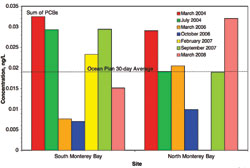

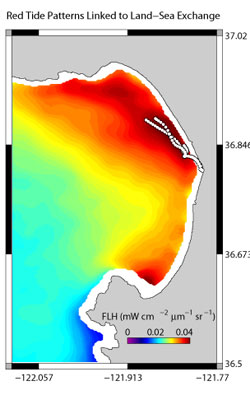
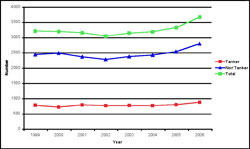


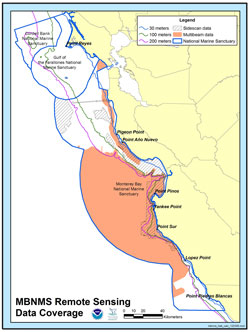
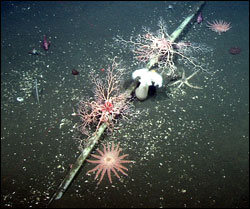
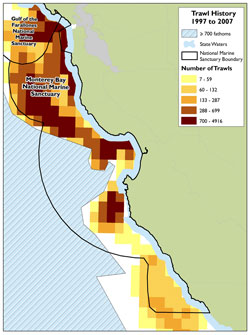
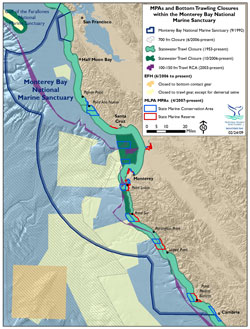
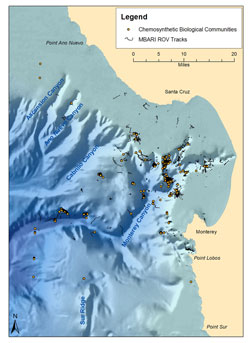
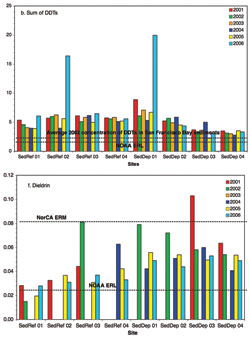

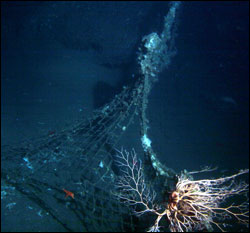

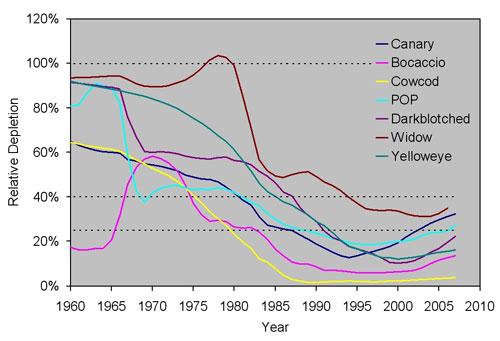
![Figure 42. Monitoring data collected by the Monterey Bay Aquarium Research Institute were used to create time series of anomalies, with higher [or lower] than normal values in red [or blue]. (A) 0 m temperatures have in general remained cool since 1998, resulting in high (C) 60 m nitrate and (D) 0 m chlorophyll (overall phytoplankton biomass) values. However, centric diatoms decreased sharply in 2003 and were apparently replaced by (E) dinoflagellates in 2004. This phytoplankton switch may have been caused by increased (B) near-surface stratification (0-20 m difference in the water density parameter, sigma-t) which resulted from decreased wind-driven upwelling after 2003. Timing of two El Ni�os (pink column) and one La Ni�a (light blue column) are shown. Source: Pennington et al. 2007](images/fig42.jpg)
